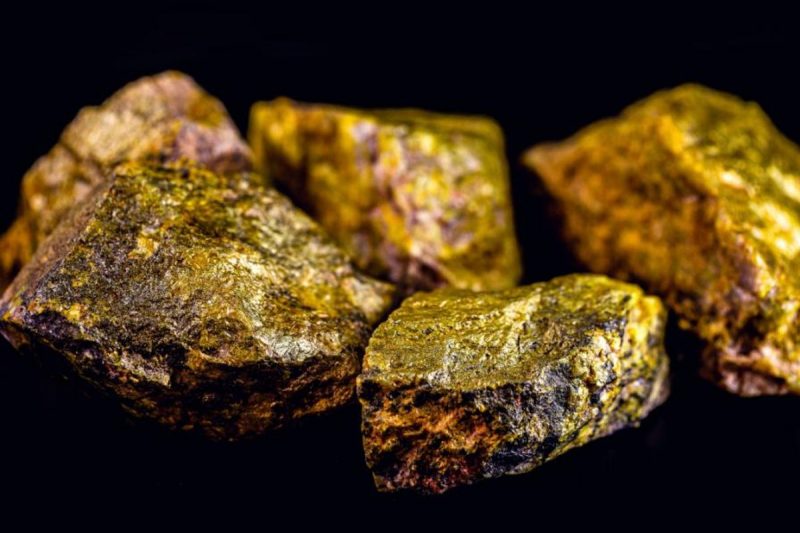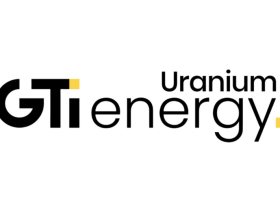The uranium spot price hit a 14 month high of US$57.75 per pound in Q2.
Although the commodity remains below its April 2022 decade high of US$64.50, its outlook remains strong given market forces impacting both supply and demand. Russia’s ability to bring nuclear fuel to market is weighing on the supply side as the country is responsible for nearly half of global capacity for uranium conversion and enrichment. On the demand side, governments around the world continue to build out their nuclear power capacity in an effort to move away from fossil fuels.
Tiggre mentioned uranium as a sector he’s investing in right now. For his part, King shared a list of companies focused on the energy metal that he is keeping an eye on, including Cameco (TSX:CCO,NYSE:CCJ), one of the year’s biggest gainers. Rule highlighted the major catalyst he’s on the look out for that will truly signal a rebound in the uranium market.
Below are the top uranium stocks on the TSX, TSXV and CSE by share price performance so far this year. All data was obtained on July 24, 2023, using TradingView’s stock screener, and all companies had market caps above C$10 million at the time.
1. Stallion Discoveries (TSXV:STUD)
Year-to-date gain: 84 percent; market cap: C$21.85 million; current share price: C$0.23
In 2023, Stallion Discoveries has amassed a large land package in the Athabasca Basin, home to the world’s largest high-grade uranium deposits. If it chooses to exercise an option it acquired in July, the company’s vast holdings will total more than 3,000 square kilometers. Stallion also has two gold projects in Idaho and Nevada.
Stallion’s share price kicked off the year by climbing significantly, nearly quadrupling by mid-February. During the month of January, the company made two significant acquisitions that totaled 23 mineral claims covering 78,831 hectares in strategic locations throughout the Athabasca Basin. In February, Stallion completed a C$4 million financing. Shares of Stallion climbed from C$0.13 on January 3 to C$0.48 on February 17.
On March 1, the uranium explorer initiated a versatile time-domain electromagnetic geophysical survey for the aforementioned 78,831 hectares in the basin. “Given that this survey has been a key starting point for many companies in the region, to not only locate, but successfully outline conductors, it will lay the groundwork for our prospective target areas moving forward,” said CEO Drew Zimmerman.
While Stallion’s share price eased back to the C$0.35 to C$0.40 range for much of March and early April, news that the survey was completed and moving into the interpretation phase gave it a boost. Zimmerman called the survey’s completion “the key first step on a proven exploration roadmap in the area.”
On May 3, Stallion’s share price reached C$0.50, a year-to-date high for the company. However, in recent months, the company has sunk to the C$0.20 to C$0.24 range.
In mid-July, the company announced a definitive agreement with ATHA Energy (CSE:SASK,OTCQB:SASKF) that gives Stallion the option to acquire a 70 percent interest in 47 mineral claims covering 547,524 acres in the Western Athabasca Basin; doing so would bring the company to a total 3,000 square kilometer land package.
2. Strathmore Plus Uranium (TSXV:SUU)
Year-to-date gain: 78.13 percent; market cap: C$20.33 million; current share price: C$0.56
Strathmore Plus Uranium is a pure-play uranium company operating in the US state of Wyoming. The company has three projects in the state, namely Night Owl, Agate and Beaver Rim. Strathmore is working to advance Night Owl, which hosts a past-producing uranium mine, to production as a shallow conventional mine.
Strathmore’s share price saw various peaks in the first quarter, initially rising in mid-January after multiple news releases, including a private placement financing and the granting of stock options. The company also initiated permitting efforts at Night Owl, explaining in a release the activities it will be undertaking to complete the necessary baseline studies for the project.
On February 22, Strathmore submitted a permit for a 100 hole drill program at the Agate project this summer. The company will be exploring Agate alongside Dr. Brad Carr and his research team from the University of Wyoming, which Strathmore announced a partnership with in January. The university team will be digitizing the project’s historical drill data and applying “newly developed geophysical theories and methods to evaluate the uranium mineralization at the properties.”
On April 3, Strathmore announced an agreement with Ur-Energy (TSX:URE,NYSEAMERICAN:URG) that will see the two companies evaluate how to advance Strathmore’s projects and look into a potential business transaction for the processing of Strathmore’s future uranium at Ur-Energy’s facilities. The next day, the company received the requested drill permit for Agate.
Although Strathmore did not release news over the next month, its share price climbed to a year-to-date high of C$0.91 by May 1, up from C$0.38 on March 21, before moving back down to C$0.47 on May 30. More recent news releases highlighting planned exploration programs at Night Owl and Agate for this summer helped push its shares back up to C$0.56 as of July 24.
3. Cosa Resources (CSE:COSA)
Year-to-date gain: 69.44 percent; market cap: C$10.46 million; current share price: C$0.30
Cosa Resources holds more than 140,000 hectares of uranium assets proximal to the Athabasca Basin. These projects are near to or within highly prospective northeast-trending uranium corridors and district-scale structural corridors, such as the Cable Bay and Grease River shear zones and the Larocque trend. The company’s 100 percent owned Ursa property covers a large portion of the underexplored Cable Bay shear zone uranium corridor.
In mid-January, Cosa acquired 41,119 hectares of uranium exploration ground along the Cable Bay shear zone and contiguous with the company’s Ursa property. A few weeks later, the company added to its expertise with the appointment of veteran uranium geologist Andy Carmichael. Shares of the uranium explorer rose from C$0.17 on January 3 to a year-to-date high of C$0.47 on February 6.
Later in the spring, Cosa acquired the 12,835 hectare Helios uranium property in Athabasca. ‘Similar to our Ursa project, this is an example of our technical team leveraging past experience and discovery success to identify overlooked, cost-effective acquisitions,” said President and CEO Keith Bodnarchuk. Soon after, the company further stacked its bench with award-winning uranium geologist Justin Rudko.
While Cosa’s share price had sunk from its year-to-date high to as low as C$0.28 on March 17, upward momentum beginning in early April pushed it back up to C$0.44 on April 19.
Since then, the company has reported on geophysical survey results for its Castor and Charcoal and Ursa and Orion projects, announced the acquisition of the Astro and Orbit projects and closed a C$5.5 millionprivate placement.
While Cosa was able to sustain its share price in the C$0.38 to C$0.42 range for the remainder of the second quarter, it has trended downward so far in the third quarter, with shares trading at C$0.31 as of July 24. Looking forward, the company has a series of exploration activities planned for fall 2023 and into 2024.
4. District Metals (TSXV:DMX)
Year-to-date gain: 53.33 percent; market cap: C$12.3 million; current share price: C$0.115
District Metals has built a portfolio of polymetallic exploration and development projects, with its main focus being the Viken uranium-vanadium project and the polymetallic Tomtebo project in Sweden. The Viken property covers 68 percent of the Viken deposit, which is amongst the largest deposits by total historic mineral resources of uranium and vanadium in the world. The deposit also hosts significant molybdenum, nickel, copper and zinc mineralization. In addition to these, the company has the Tåsjö and Ardnasvarre polymetallic projects, which are both prospective for uranium.
District Metals started off the year with the submission of a mineral license application for the Viken property. Later in the month, the company shared a media report about the potential for Sweden’s 2018 moratorium on uranium exploration and mining to be lifted by an upcoming vote in Swedish parliament.
Shares of District Metals benefited from the reports, more than doubling in value from C$0.08 on January 4 to C$0.18 on January 26.
In early March, the company completed a financing totaling C$3 million and announced an additional mineral license application for Viken that brings the total area covered from 2,302 to 9,367 hectares. District Metals’ share price hit its year-to-date high of C$0.23 shortly after on March 8.
The vote from Swedish parliament to keep the country’s uranium moratorium in place for the time being pushed District Metals’ share price back down to C$0.10 by March 30. The stock traded between C$0.10 and C$0.11 through the second quarter before rising to C$0.13 July 7.
Support for the country’s uranium industry came on June 19 in the form of a Swedish news article with quotes from multiple politicians. Swedish Minister for the Environment Romina Pourmokhtari stated, “I believe that we need uranium mines in Sweden,” according to the article, and Swedish Minister for Energy and Business Ebba Busch said, “Sweden also needs more uranium to achieve greater fossil-free electricity production.”
The company has reported approvals for multiple licenses so far this year, in particular its Viken mineral licenses on April 12 and May 3; its Tåsjö mineral license applications on May 30; and its Ardnasvarre mining license on June 22.
5. Cameco (TSX:CCO)
Year-to-date gain: 40.85 percent; market cap: C$18.67 billion; current share price: C$43.44
Cameco is a top global uranium miner with active operations in Canada and Kazakhstan and suspended mines in the US. Its Canadian mines are the Cigar Lake joint venture, the world’s highest-grade uranium mine, and McArthur River/Key Lake, the world’s largest high-grade uranium mine and mill. Both are in Saskatchewan’s Athabasca Basin. After being on care and maintenance, Cameco brought McArthur River/Key Lake back online in 2022 due to strengthening uranium market conditions, and it achieved initial production last November. Cameco’s Inkai mine in Kazakhstan is a 40/60 joint venture between it and national operator Kazatomprom (LSE:KAP).
Cameco’s share price climbed throughout the first month and a half of 2023, reaching C$39.67 on February 15. On February 8, the uranium miner reached a supply agreement with Ukraine’s state-owned nuclear energy utility company, Energoatom. The deal will see Cameco supply Ukraine with enough uranium fuel to meet the country’s needs until 2035.
The following day, Cameco released its Q4 and full-year 2022 results. The year saw Cameco sign a record number of uranium contracts, ultimately reaching an additional 80 million pounds of uranium to its long-term contracts. The company also discussed its big news items for last year, and shared its guidance for 2023.
More significant news came for Cameco on March 27, when the company shared that Canada Revenue Agency will be refunding the company C$300,000 in previously paid taxes after a series of court battles. Although Cameco’s share price had drifted lower since mid-February, this news led to a hike in its share price over the following days. On April 4, the company extended its nuclear fuel supply agreement with Ontario-based power company Bruce Power until 2030.
In late April, Cameco released its Q1 financials, highlighting C$115 million in adjusted net earnings, plus production of 4.5 million pounds of uranium. The company now has ‘contract commitments of approximately 215 million pounds of uranium and more than 70 million kgU of UF6 conversion services with deliveries spanning more than a decade.’ Shares of Cameco hit a year-to-date high of C$43.44 on July 24.
FAQs for investing in uranium
What is uranium used for?
Uranium is primarily used for the production of nuclear energy, a form of clean energy created in nuclear power plants. In fact, 99 percent of uranium is used for this purpose. As of 2022, there were 439 active nuclear reactors, as per the International Atomic Energy Agency. Last year, 8 percent of US power came from nuclear energy.
The commodity is also used in the defense industry as a component of nuclear weaponry, among other uses. However, there are safeguards in effect to keep this to a minimum. To create weapons-grade uranium, the material has to be enriched significantly — above 90 percent — to the point that to achieve just 5.6 kilograms of weapons-grade uranium, it would require 1 metric ton of uranium pre-enrichment.
Because of this necessity, uranium enrichment facilities are closely monitored under international agreements. Uranium used for nuclear power production only needs to be enriched to 5 percent; nuclear enrichment facilities need special licenses to enrich above that point for uses such as research at 20 percent enrichment.
The metal is also used in the medical field for applications such as transmission electron microscopy. Before uranium was discovered to be radioactive, it was used to impart a yellow color to ceramic glazes and glass.
Where is uranium found?
The country with the greatest uranium reserves by far is Australia — the island nation holds 28 percent of the world’s uranium reserves. Rounding out the top three are Kazakhstan with 15 percent and Canada with 9 percent.
Although Australia has the highest reserves, it holds uranium as a low priority and is only fourth overall for production. All its uranium output is exported, with none used for domestic nuclear energy production.
Kazakhstan is the world’s largest producer of the metal, with production of 21,819 metric tons in 2021. The country’s national uranium company, Kazatomprom, is the world’s largest producer.
Canada’s uranium reserves are found primarily in its Athabasca Basin, and the region is a top producer of the metal as well, although some of the major mines have been under care and maintenance in recent years.
Why should I buy uranium stocks?
Investors should always do their own due diligence when looking at any commodity so that they can decide whether it fits into their investment plans. With that being said, many experts are convinced that uranium has entered into a significant bull market, meaning that uranium stocks could be a good buy.
A slew of factors have led to this bull market. While the uranium industry spent the last decade or so in a downturn following the 2011 Fukushima nuclear disaster, discourse has been building around the metal’s use as a source of clean energy, which is important for countries looking to reach climate goals. Nations are now prioritizing a mix of clean energies such as solar and wind energy alongside nuclear. Significantly, in August 2022, Japan announced it is looking into restarting its idled nuclear power plants and commissioning new ones. Experts consider this an important catalyst for uranium.
Uranium prices are very important to uranium miners, as in recent years levels have not been high enough for production to be economic. However, in 2021, prices spiked from the US$30 to US$45 range, and moved even higher in 2022 on supply concerns from the Russia/Ukraine war, hitting US$64.50 before moving back to stabilize around US$50. This price action has resulted in some companies bringing their mines out of care and maintenance, including Cameco’s McArthur River/Key Lake.
Securities Disclosure: I, Melissa Pistilli, hold no direct investment interest in any company mentioned in this article.





